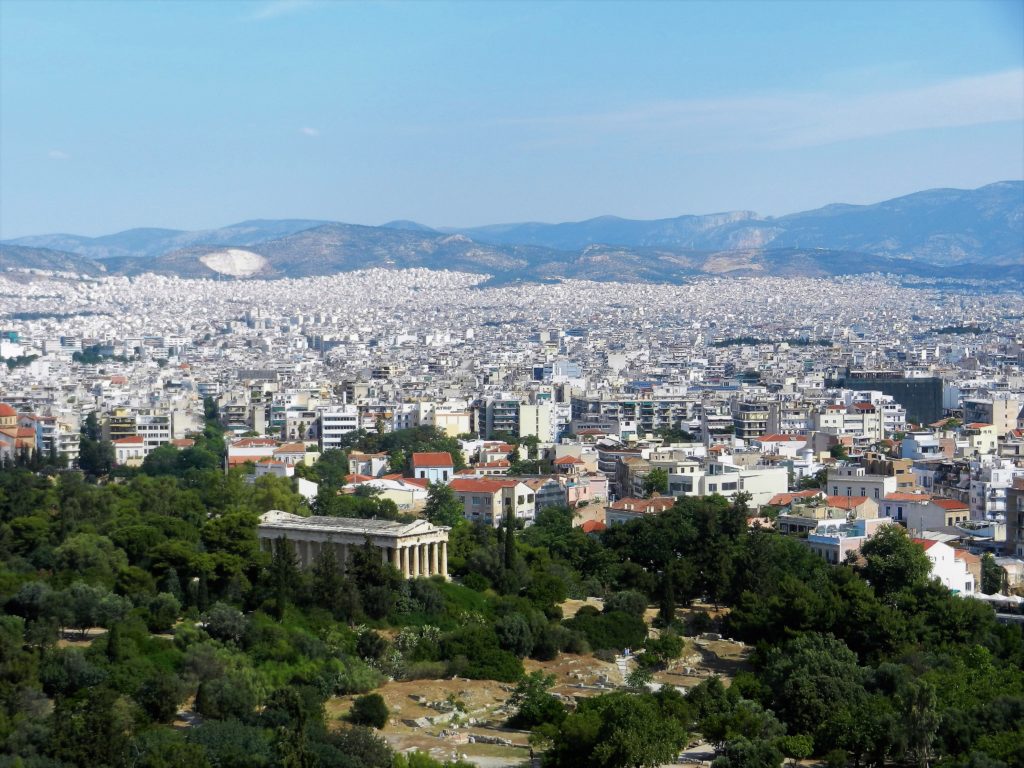 Athens, one of the oldest cities in the world, has been a thriving metropolis for thousands of years. More than a third of Greece’s population sprawls across the Attica plain amidst ruins of ancient grandeur. Athens is known as the founding place of western civilization: its arts, politics and philosophy. It has always been a highly revered city, even to foreign conquerors who would choose not to attack it out of respect. The Athens of today is still the political, business, and artistic centre of Greece and much beloved by the rest of the world.
Athens, one of the oldest cities in the world, has been a thriving metropolis for thousands of years. More than a third of Greece’s population sprawls across the Attica plain amidst ruins of ancient grandeur. Athens is known as the founding place of western civilization: its arts, politics and philosophy. It has always been a highly revered city, even to foreign conquerors who would choose not to attack it out of respect. The Athens of today is still the political, business, and artistic centre of Greece and much beloved by the rest of the world.
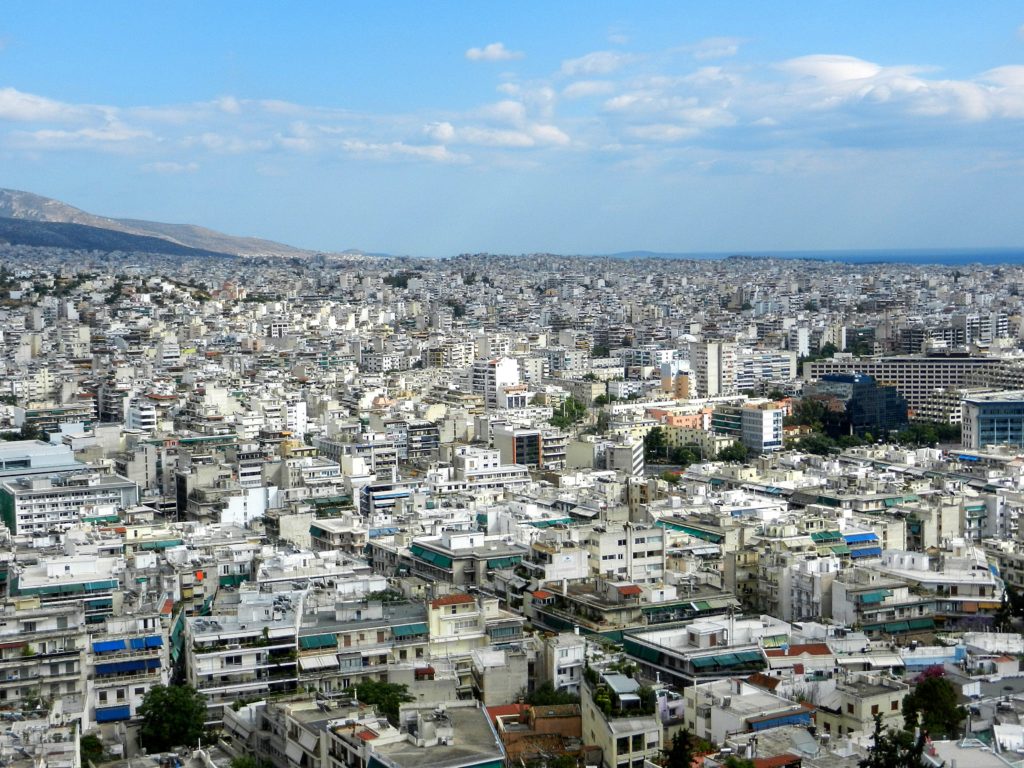
Founding of Athens
The rocky precipice upon which the Acropolis was built has been inhabited for at least 7000 years. After the fall of the Minoan Empire around 1500 BC, the Mycenaeans rose to take their place as rulers of the Aegean. The Mycenaeans built fortresses throughout their empire to maintain their dominance. An immense citadel was established on the hill where the Acropolis now stands, overlooking the settlement below. The Mycenaean’s advanced society was a precursor to the ancient Greeks.
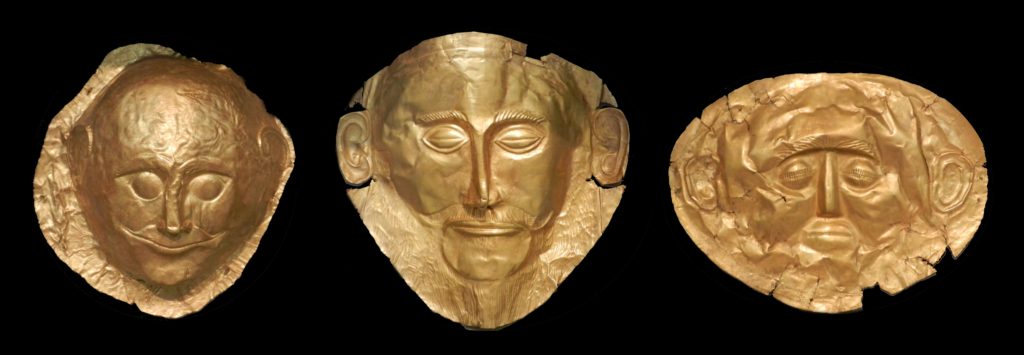
Mythology
Although scholars believe that the god Athena was named after Athens, there is an old story disputing that theory. According to legend, the first king of Athens, Cecrops, wanted to found the city under his name. The gods intervened, foreseeing a glorious future for the city they wanted to name it after themselves. A contest was declared between the gods Poseidon and Athena with King Cecrops and his citizens presiding. The god that could provide the greatest gift would win the honour of naming the city. Poseidon struck the ground with his trident and a gushing spring erupted from the earth. However, with Poseidon being the ruler of the seas, the spring produced salt water instead of drinking water. Athena dropped a seed into the earth and from it sprouted an olive tree. King Cecrops and his subjects deemed the olive tree more useful than a saltwater spring, so the city was founded under Athena’s name and became Athens.

We came to Athens by boat, from our adventures in Crete to the port of Piraeus. We booked an Airbnb room just 5 km south of the city centre for three days, hoping that would be enough time to visit the wonders of Athens. Instead of saving the best for last, once we dumped our luggage we made our way straight to the Acropolis. There were plenty of buses running in that direction but at this point in our travels we were seasoned for long walks.
Founding of Democracy
We were briefly side-tracked by the ruins of the Pnyx on our walk to the Acropolis. The Pnyx was the birthplace of democracy, a meeting place for Athenians from the 5th century BC. In theory, all citizens had the right to speak at the Pnyx’s democratic assemblies (except for women, of course). If you said anything stupid, you could be subjected to punishment, so in practice most common folk left the decision-making to the professionals. A council of 500 were selected by lottery to serve a year, guiding the assembly and preforming administrative duties. Every nine days up to 13000 citizens would gather at the Pnyx to take part in Athen’s democratic government.
Tickets and Entry Fees
From the Pnyx we followed a long line of tourists up to Greece’s top attraction: The Acropolis. We found a booth below the main entrance and bought a multi-site pass for 30 euros. This pass gave us entry to seven sites around Athens: the Acropolis, the Ancient Agora, the Roman Agora, Karameikos, the Temple of the Olympian Zeus, Hadrian’s Library and Lykeion. To just get into the Acropolis the entry fee is 20 euros, so the multi-pass is a great deal if you have more than one day in Athens.
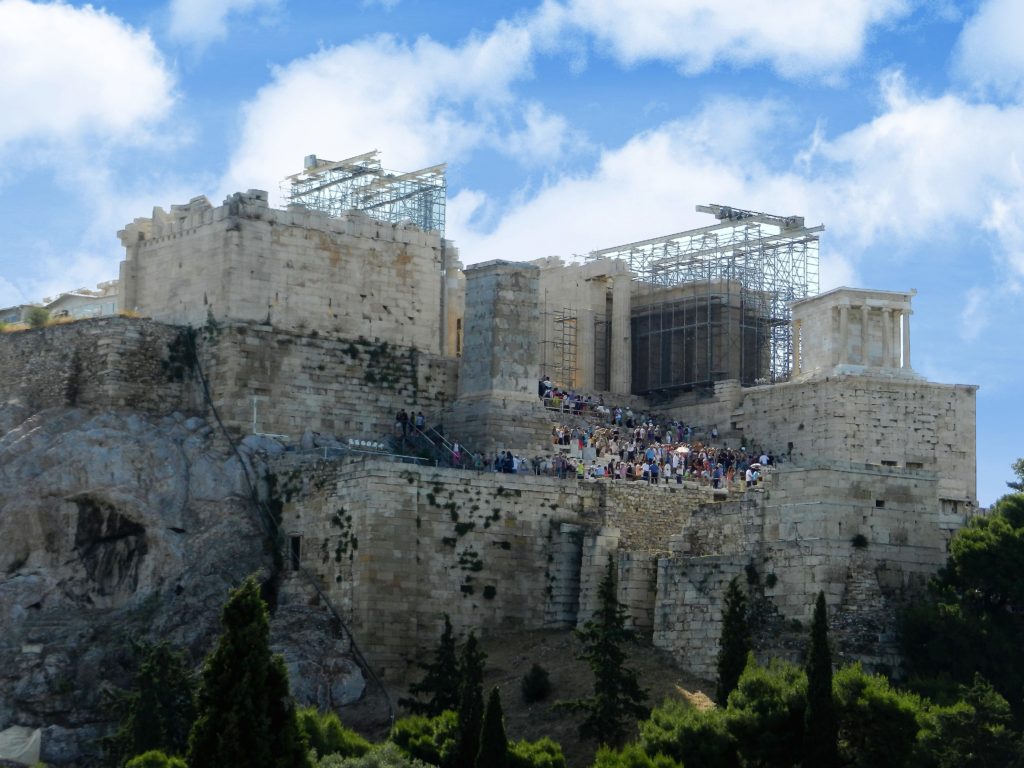
The Acropolis
This rocky citadel, crowned with three magnificent temples, is a major symbol of Greece and western civilization. Originally a Mycenaean palace, the Acropolis evolved into a religious sanctuary and a monument to the greatness of Athens.
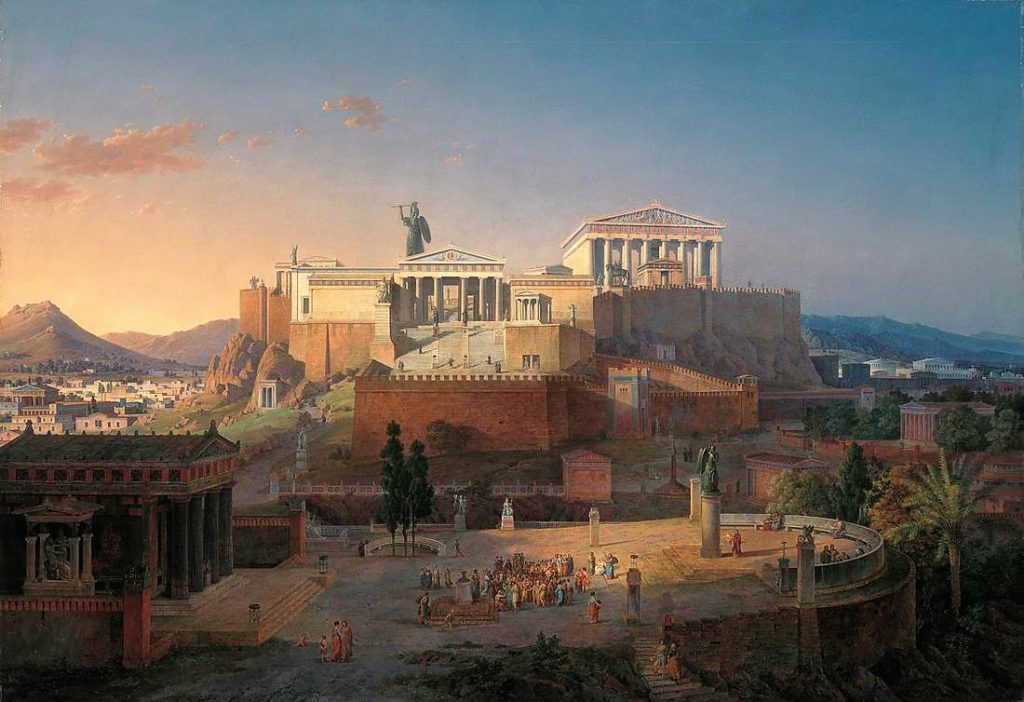
Propylaia
After climbing the stone staircase we passed through the Propylaia, the main gateway into the Acropolis. The ruins of its past splendor are still impressive to behold. The mighty, six columned facade of the Propylaia gives you a preview of the grandeur within its gates.
Parthenon
The Parthenon stands out immediately as you enter the Acropolis. This lofty temple was built in 432 BC and dedicated to the patron goddess of Athens: Athena. The Parthenon is the finest example of classical Greek architecture in the world. Throughout the ages, the temple has been shown great reverence and respect. Instead of being torn down by foreign invaders, it was re-purposed. In the 6th century it was converted into a Christian church dedicated to the Virgin Mary. In the 1460’s, during Ottoman occupation, the temple was used as a mosque. Unfortunately, centuries of care and respect for the temple ended with an ‘accidental’ explosion.

The Ottoman Empire’s attempt to invade Vienna sparked a retaliation from the west. In 1687 the Venetians attacked Athens in an attempt to take back Greek territories from the Ottomans. Turkish soldiers garrisoned themselves on the Acropolis while the Venetians had them surrounded. The Turks stored their ammunition within the Parthenon believing that the Venetians wouldn’t dare risk damaging such an important monument. The Venetians paid no heed and shelled the Acropolis for three days. Eventually, one lucky hit ignited the gunpowder inside the temple, severely damaging the Parthenon and its sculptures. If it wasn’t for this unfortunate accident, the Parthenon would be in much better shape than it is today.
Luckily, Jacques Carrey made detailed drawings of the Parthenon in 1674 before it was damaged. Using these drawings and archaeological evidence, the Committee for the Conservation of the Acropolis Monuments is carefully reconstructing the Parthenon to its former glory.
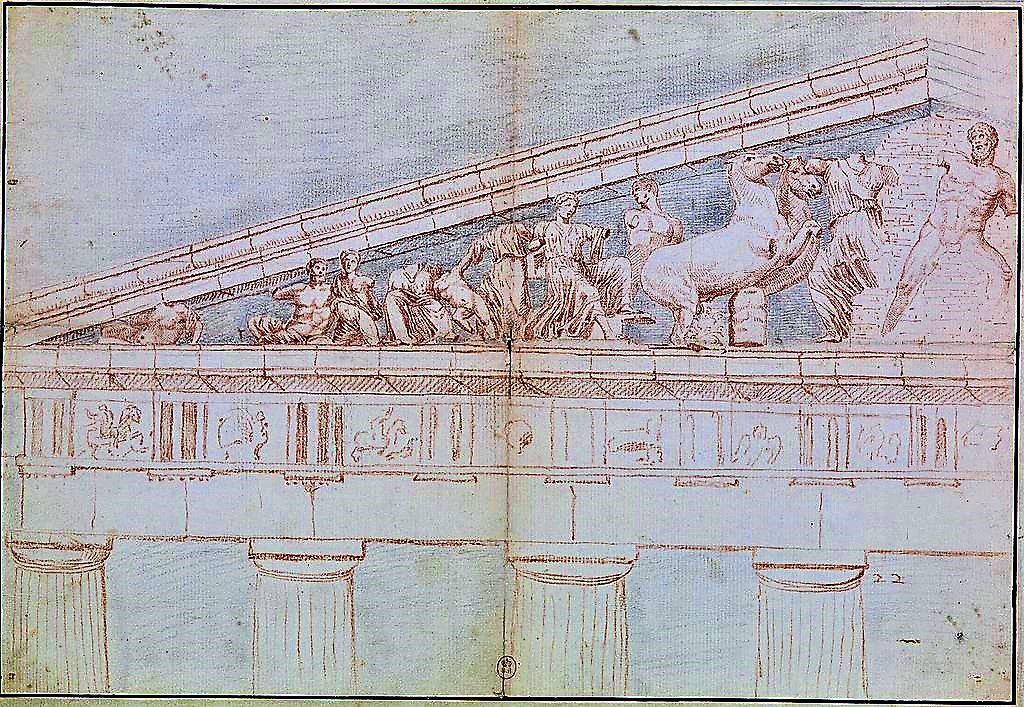
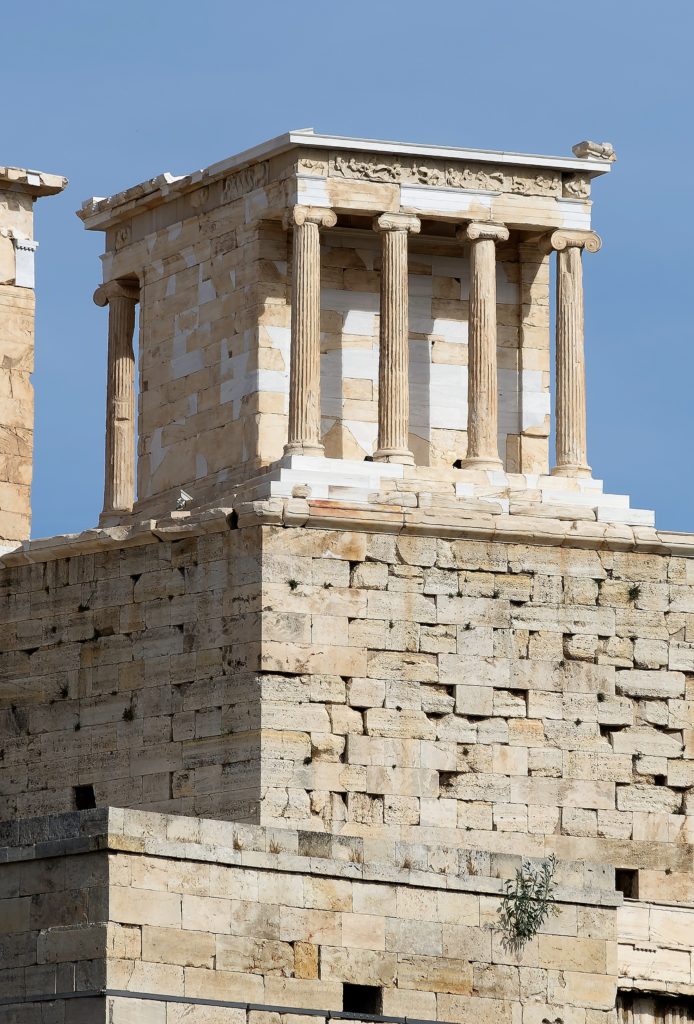
Temple of Athena-Nike
Two smaller, but no less significant, temples surround the Parthenon. At the south west corner of the Acropolis, right beside the Propylaia, is the Temple of Athena Nike. It is a very small temple with ornate carvings. A statue of Athena Nike, a version of Athena worshiped as the goddess of victory, used to reside there. The temple has been dismantled several times, in 1868 when the Ottoman Turks needed stone to fortify their position, and several times during the 20th century to fix structural issues.
Erechtheion
On the north side of the Acropolis is the Erechtheion, supposedly built on the site where Athena and Poseidon held their contest to be patron of Athens. While the Parthenon was more so a tribute to Athena than a place of worship, the Erechtheion was the temple one would go to for prayer. One notable feature is The Porch of the Caryatids, six stone maidens as supporting columns. These are replicas, the real Caryatids are kept inside the Acropolis Museum and one in the British Museum in London. Several sculptures from the Acropolis were sold to a British Lord Elgin during Ottoman occupation, and eventually sold to the British Museum. The Greek government is still trying to get these priceless statues back to where they belong.
Slopes of the Acropolis
Just when you thought it was all over, there’s a lot more to the Acropolis than the Parthenon. After visiting the main sites of the Acropolis I wanted to take a walk around the hill to look at its fortifications. I’m glad we did because there’s a lot more to see at the base of the hill. There are several caves on the north side of the hill that were lived in during Neolithic times. Over time, as the Acropolis evolved into a sacred area, these caves became shrines for the gods. Settlements on the south side of the hill were developed into theatres and sanctuaries.
The Odeon of Herodes Atticus and the Theatre of Dionysus are hard to miss. The Odeon has a three story facade, holds an audience of 5000, and used to have a cedar roof. It was originally built in 160 AD and it is still used for concerts today.
The Theatre of Dionysus is the oldest theatre in the world, built in 330 BC, a proto-type for future Roman theatres. It was built for the Great Dionysia festival, a celebration in honour of Dionysus, the god of wine, fertility and religious ecstasy.
After walking all around the Acropolis with the sun beating down on us we had our fill for the day. Luckily our multi-pass didn’t expire for five days so there was no need to rush things. After finding a tasty gyro for supper we packed it in for the night.
Ancient Agora
The next morning we tottled over to Athen’s Ancient Agora, north west of the Acropolis. The name “Agora” means “gathering place”. Like any other city centre, the Ancient Agora had a marketplace, residences and places of worship. It was also a place for public assemblies and hearings. Athenians would gather at the Agora to shop, learn, and pray.
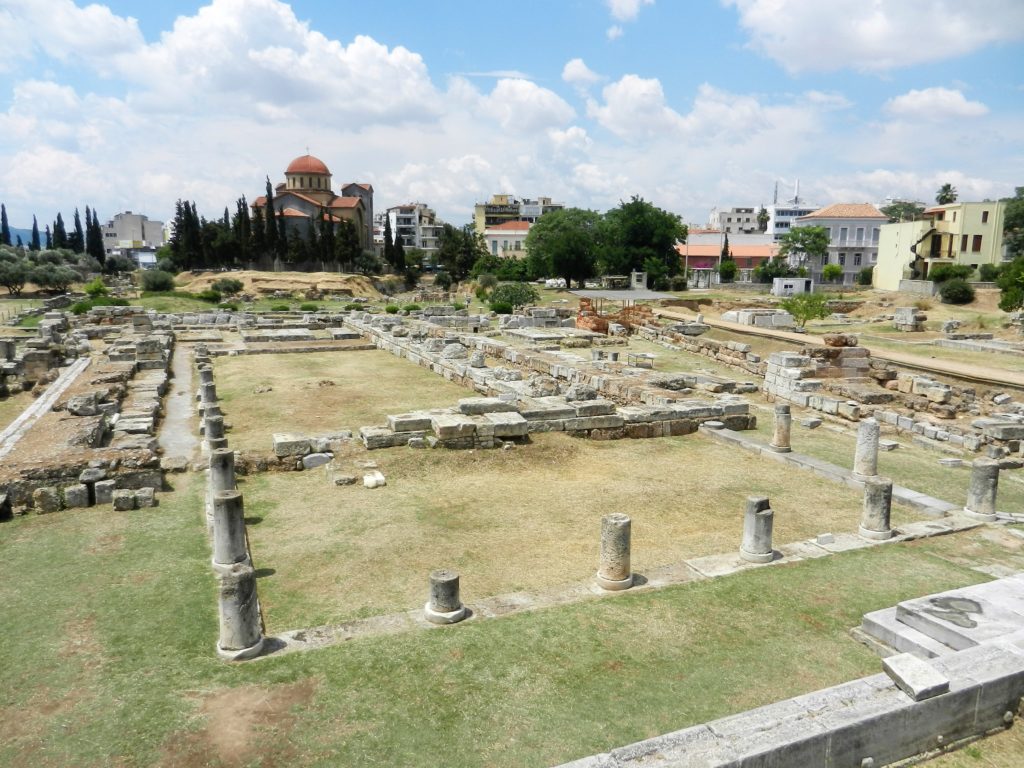
Stoa of Atallos
Although much of the Ancient Agora is in ruins, two spectacular structures stand out. The Stoa of Atallos and the Temple of Hephaestus. The Stoa of Atallos you see today is actually a 20th century recreation of the original which was destroyed in 267 AD. This marble edifice was 115 metres long, had two floors and 42 rooms. Each room had its own shop and artisan. Athenians would come to the stoa to hide from harsh weather, hangout and socialize.
Temple of Hephaestus
The Temple of Hephaestus, built around 420 BC, is the best preserved classical Greek temple to date. From the 7th century it was used as a Christian church until the 19th century, thus saving it from dereliction. Many of the original carvings are still intact; you can find scenes depicting the deeds of Theseus and Heracles around the temple. Inside the Hephaisteion once stood statues of the gods Athena and Hephaestus, patrons of the arts. In legend the two gods, through unconventional means, gave birth to the one of earliest kings of Athens: Erichthonios.
Roman Agora
Right across the street from the Ancient Agora is the Roman Agora, built many centuries later. During Roman occupation, Julius Caesar invested in Athens, renovating the Greek agora and constructing a new agora in the 1st century BC. Unlike the old one, the Roman Agora was purely a marketplace with shops and artisans.
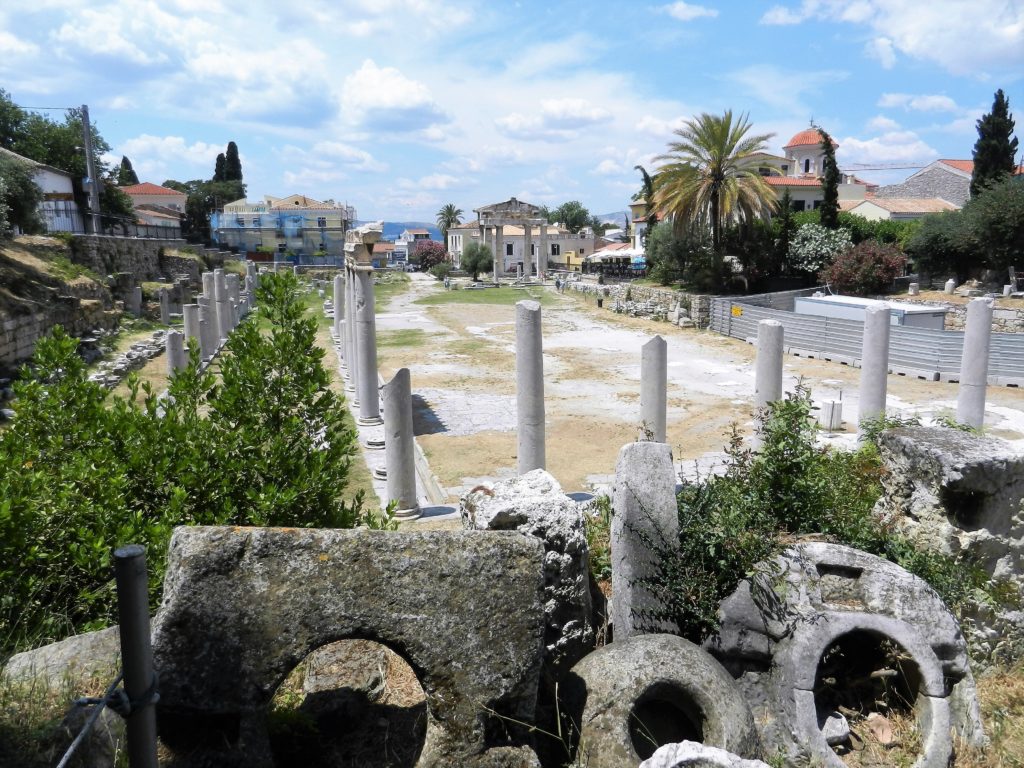
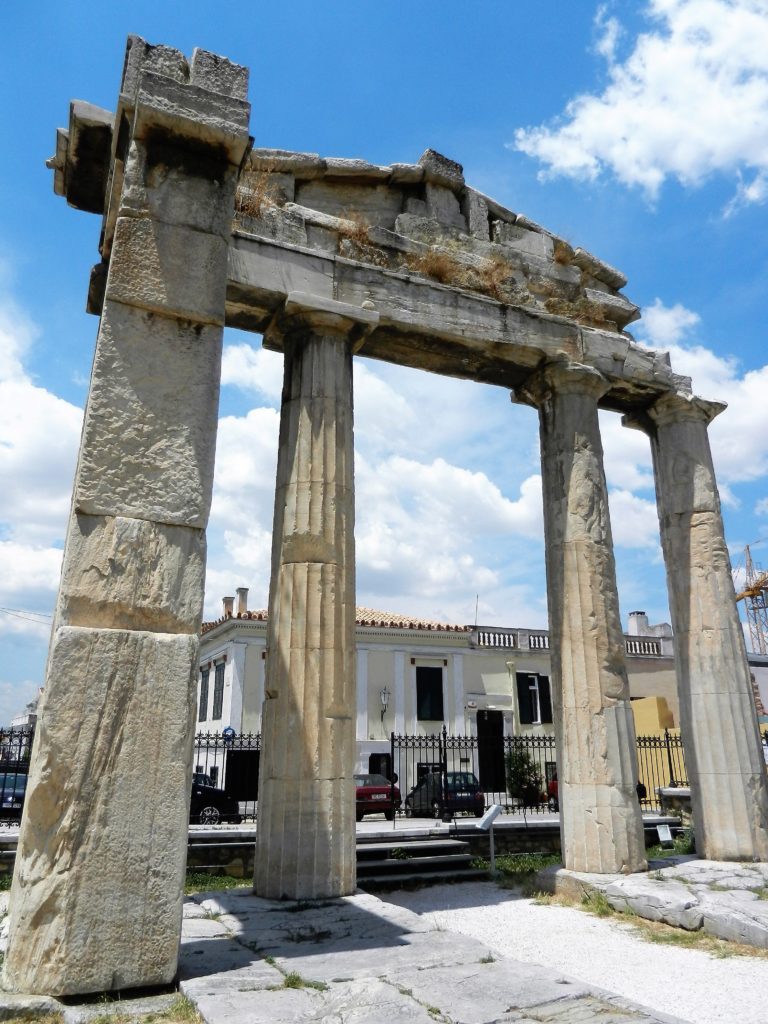
Gate of Athena Archegetis
At the main entrance to the market is the Gate of Athena Archegetis, still obstinate to time and the elements. It was designed to resemble the facade of a classical Greek temple and was devoted to the goddess Athena. The Romans assimilated Greek architecture, art, religion and philosophies into their own. This shows us just how much reverence they held for classical Greek culture.
Tower of the Winds
An exquisitely unique, octagonal tower stands at the eastern end of the Roman Agora. The Tower of the Winds was built in the 2nd century by a Macedonian astronomer, Andronicus of Cyrrhus. Eight wind deities decorate each side of the tower, symbolising the eight directions of the wind. It functioned as a meteorological station with a sundial, water clock and a weather vane. Unfortunately, during our visit it was completely covered in scaffolding and closed to the public, but you can’t time everything right.
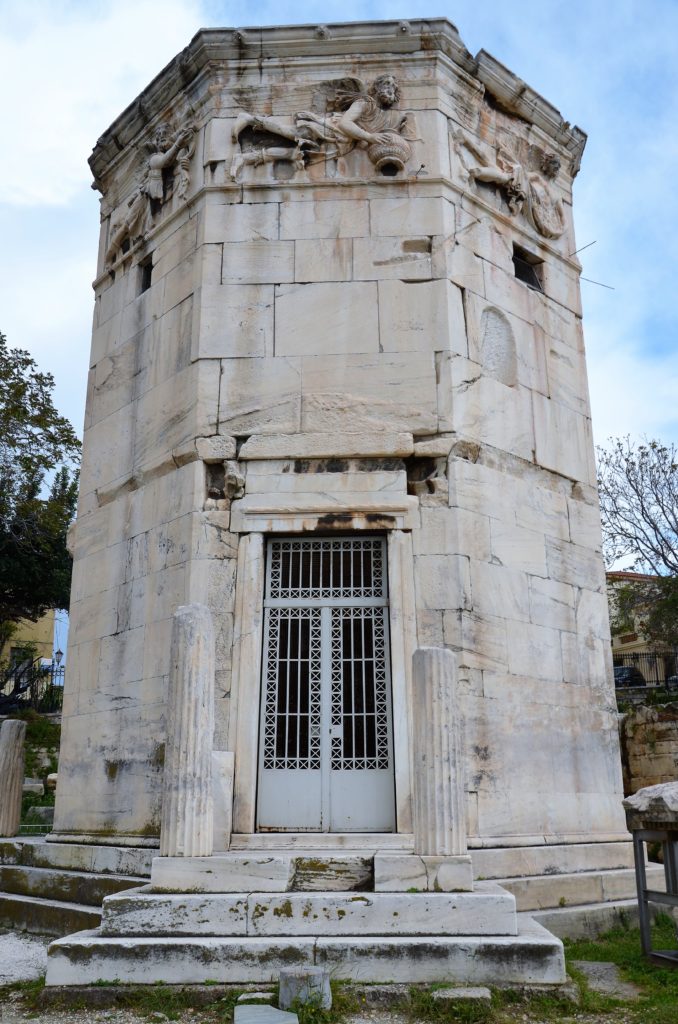
Temple of the Olympian Zeus
There was one last classical Greek marvel we needed to see: the Temple of the Olympian Zeus. We made our way to the eastern side of the Acropolis and already we could spy it’s mighty columns towering in the distance. This temple is the largest in Greece, with beautiful Corinthian columns rising up to the sky like tree trunks.
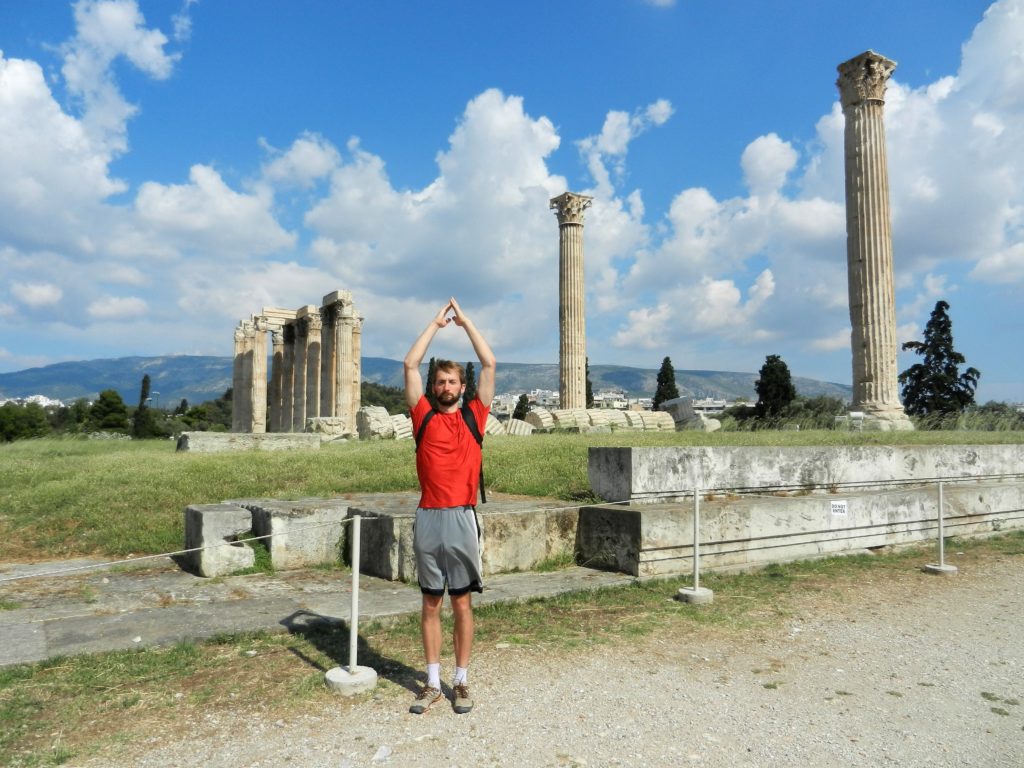
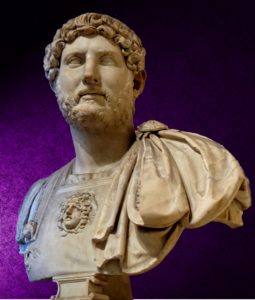
Construction of the Zeus’ temple began in the 6th century BC by Athenian ruler Peisistratos. The monument was left unfinished for around 700 years until Roman Emperor Hadrian finally completed the project. He also put two, gigantic golden ivory statues inside the temple, one of Zeus and an equivalent statue of himself. This was Hadrian’s subtle way of telling everyone that he was of equal status to the head of the Olympian Gods. Of course, these statues are gone, probably chopped up and melted down at some point in history.
Sadly, only 16 of the original 104 columns remain after centuries of stone robbery and natural disasters. But, standing next to its colossal remains and looking at the space it would have filled, you can feel the Olympian’s powerful presence.
National Archaeological Museum
On our third day in Athens we decided to take it easy after touring like crazy people. We couldn’t leave Athens, however, without seeing some of the priceless artifacts at the National Archaeological Museum (plus it was a nice reprieve from the sun’s wrath). Having toured around Europe for 20 months straight at this point we were pretty tired of museums, but the Archaeological Museum still caught my interest.
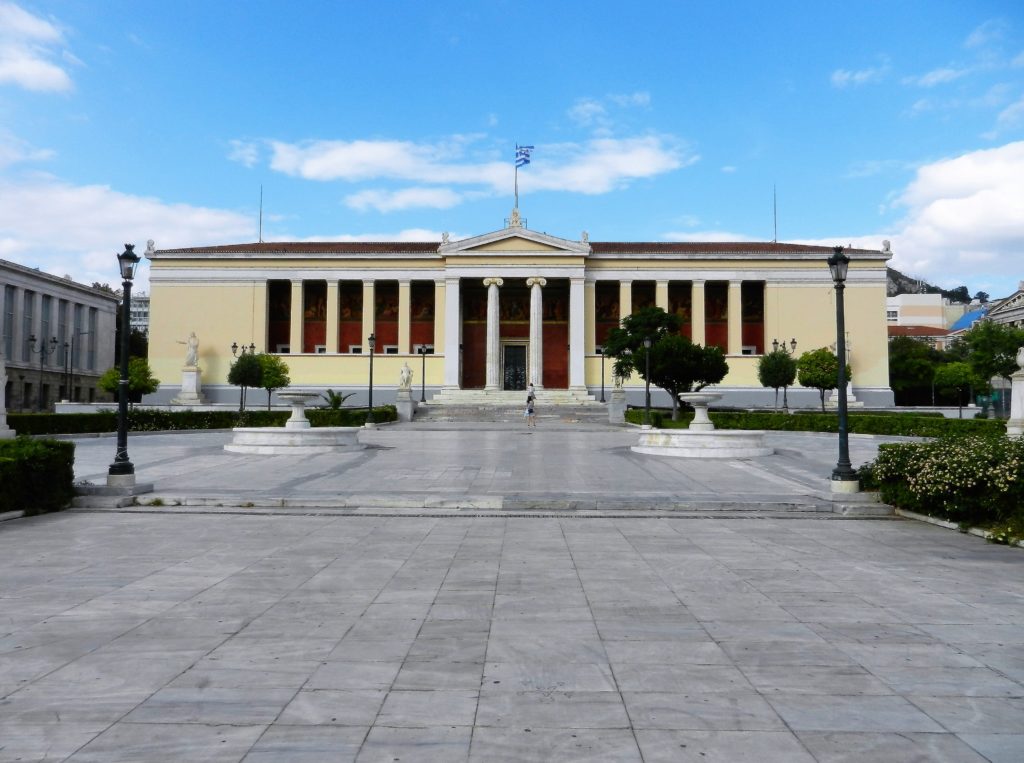
The entrance fee for the museum wasn’t included in our multi-pass, but for a mere 5 euros you get to see Aegean artifacts as old as 6000 BC to the Classical era. Exquisite gold relics, ancient weapons, black figure pottery, and mythological sculptures are housed in this 8000 square metre building. Wandering, overwhelmed, through its 15000 exhibits, I recognized many sculptures and vases depicting popular Greek myths. A bronze mask of Medusa, a marble sculpture of the Minotaur, and a vase depicting Heracles battling the Hydra filled my mind’s eye with the legends I heard growing up. I saw the famous golden mask of Agamemnon, an artifact I distinctly remember from my high school textbook. My other two favourite treasures were the bronze statue of Zeus and the Horse and Jockey, both found at the bottom of the sea.
Monument of Philopappos
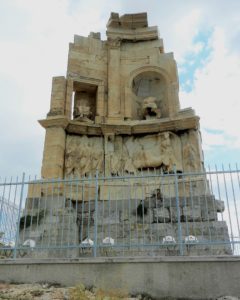
We had arranged to meet with a Couchsurfer host Michael outside the Archaeological Museum on our final day in Athens. Originally we had contacted Michael for a place to stay, and although he couldn’t oblige he offered to meet us for coffee. Michael took us on a long walk through parts of Athens we hadn’t noticed before and up to the Monument of Philoppapos. It was nice hanging out with a local Athenian and getting a more personal perspective on his home city.
It was a peaceful walk out of the dense urban atmosphere up Muse hill. The monument at its summit is also a tomb for the Roman Magistrate Philopappos, much beloved by the people of Athens. I loved the cobblestone walkway winding up the hill to such a spectacular view of Athens. From that vantage point I could observe all the temples and agoras, ancient islands in a modern metropolis. I could hardly believe I was standing there, looking down at the city where western civilization began. Mostly everything about our western society can be traced back to the Ancient Greeks: language, arts, architecture, politics, technologies, ethics, and philosophies. It was a perfect ending to our Athens adventure!










































